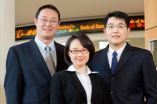(Press-News.org) ATHENS, Ohio (Jan. 10, 2013)—An international team of scientists has taken the next step in creating nanoscale machines by designing a multi-component molecular motor that can be moved clockwise and counterclockwise.
Although researchers can rotate or switch individual molecules on and off, the new study is the first to create a stand-alone molecular motor that has multiple parts, said Saw-Wai Hla, an Ohio University professor of physics and astronomy who led the study with Christian Joachim of A*Star in Singapore and CEMES/CNRS in France and Gwenael Rapenne of CEMES/CNRS.
It's an essential step in creating nanoscale devices—quantum machines that operate on different laws of physics than classical machines—that scientists envision could be used for everything from powering quantum computers to sweeping away blood clots in arteries.
In the study, published in Nature Nanotechnology, the scientists demonstrated that they could control the motion of the motor with energy generated by electrons from a scanning tunneling microscope tip. The motor is about 2 nanometers in length and 1 nanometer high and was constructed on a gold crystal surface.
At a temperature of minus 315 degrees Fahrenheit, the motor could move independently through thermal excitation. When scientists cooled the sample to minus 450 degrees, the motor stopped rotating. The researchers selectively applied electron energy to different parts of the motor to prompt it to move clockwise and counterclockwise.
"If we want to build an actual device based on this motor, we would install electrodes on the surface to create an energy source," Hla said.
To construct the molecular motor, the scientific team designed a stationary base of atoms that is connected to an upper moving part by one atom of ruthenium, which serves as the "ball bearing." The upper piece of the motor features five arms made of iron atoms. The researchers made one arm shorter than the others to be able to track the motion of the machine. The entire device is held upright by using sulfur as an "atomic glue" to secure the motor to the gold surface, Hla explained.
The scientists now plan to use this model to build more complex machines with components that could be automated, Hla said.
INFORMATION:
The study was funded by the AUTOMOL project, the U.S. Department of Energy, the A*STAR Atom Tech VIP programme phase III, CNRS and the University Paul Sabatier of Toulouse.
In addition to Hla, Joachim and Rapenne, the study authors include U. Perera, H. Kersell and Y. Zhang of Ohio University; G. Vives, J. Echeverria and M. Grisolia of CEMES/CNRS, and F. Ample of IMRE, A*STAR in Singapore.
Contacts: Saw-Wai Hla, hla@ohio.edu; Christian Joachim, Joachim@cemes.fr; Andrea Gibson, director of research communications, (740), 597-2166, gibsona@ohio.edu.
Scientists design, control movements of molecular motor
Study offers blueprint for creating machines at the nanoscale
2013-01-10
ELSE PRESS RELEASES FROM THIS DATE:
Giant tobacco plants that stay young forever
2013-01-10
The life of tobacco plants is short. They grow for around three to four months, followed by flowering and then die. Their size is also limited, with plants only growing to about one-and-a-half to two meters tall. Now, researchers at the Fraunhofer Institute for Molecular Biology and Applied Ecology IME in Münster have located the tobacco plant's very own fountain of youth, which means they can keep it forever young. The Münster-based researchers discovered a genetic switch which can prevent the plants from change blooming to flowering. This also averts the plants' early ...
Surgeons may use hand gestures to manipulate MRI images in OR
2013-01-10
WEST LAFAYETTE, Ind. — Doctors may soon be using a system in the operating room that recognizes hand gestures as commands to tell a computer to browse and display medical images of the patient during a surgery.
Surgeons routinely need to review medical images and records during surgery, but stepping away from the operating table and touching a keyboard and mouse can delay the procedure and increase the risk of spreading infection-causing bacteria, said Juan Pablo Wachs, an assistant professor of industrial engineering at Purdue University.
"One of the most ubiquitous ...
Which study strategies make the grade?
2013-01-10
Students everywhere, put down those highlighters and pick up some flashcards! Some of the most popular study strategies — such as highlighting and even rereading — don't show much promise for improving student learning, according to a new report published in Psychological Science in the Public Interest, a journal of the Association for Psychological Science.
In the report, John Dunlosky of Kent State University and a team of distinguished psychological scientists review the scientific evidence for ten learning techniques commonly used by students.
"Schools and parents ...
Cutting in and weaving irritate drivers the most, new CAMH study on road rage shows
2013-01-10
January 10, 2013 (Toronto) - Cutting in and weaving, speeding, and hostile displays are among the top online complaints posted by drivers, according to a new study by the Centre for Addiction and Mental Health (CAMH) recently published in an online issue of Accident Analysis and Prevention.
Driver aggression is a major safety concern and researchers estimate this behaviour is a factor in nearly half of all motor vehicle collisions. Identifying the underlying causes and strategies for preventing driver aggression continues to be a priority.
CAMH researcher Dr. Christine ...
High-frequency stock trading of little value to investors, general public
2013-01-10
The increase in the speed of stock trading from microseconds to nanoseconds leads to an increase in order cancellation, but little else of value to investors and the general public, says research by a University of Illinois business professor.
According to a forthcoming study by Mao Ye, a professor of finance at Illinois, the arms race in speed at the sub-millisecond level of stock trading is a "purely positional game" in which a trader's payoff depends on transaction speed relative to other traders.
"There are lots of extreme views about high-frequency trading, but ...
Decline in available liver transplants expected
2013-01-10
A new study, funded in part by the National Institutes of Health (NIH) and Health Resources and Services Administration, and published in the January 2013 issue of Liver Transplantation, a journal of the American Association for the Study of Liver Diseases (AASLD), found that the non-use of donor livers climbed through 2010 due to a worsening of donor liver quality, primarily from donation following cardiac death. Diabetes, donor age, and body mass index (BMI) were also linked to a decrease in use of organs.
"For patients with end-stage liver disease, transplantation ...
Lower nitrogen losses with perennial biofuel crops
2013-01-10
URBANA – Perennial biofuel crops such as miscanthus, whose high yields have led them to be considered an eventual alternative to corn in producing ethanol, are now shown to have another beneficial characteristic–the ability to reduce the escape of nitrogen in the environment. In a 4-year University of Illinois study that compared miscanthus, switchgrass, and mixed prairie species to typical corn-corn-soybean rotations, each of the perennial crops were highly efficient at reducing nitrogen losses, with miscanthus having the greatest yield.
"Our results clearly demonstrate ...
This week in Blood: Jan. 10, 2013
2013-01-10
Welcome to "This Week in Blood," a weekly snapshot of the hottest studies from each week's issue of Blood, the official journal of the American Society of Hematology (ASH), hand-picked by Blood Editor-in-Chief Bob Löwenberg, MD, and Deputy Editor Nancy Berliner, MD.
Systemic delivery of a TLR7 agonist in combination with radiation primes durable anti-tumor immune responses in mouse models of lymphoma, Dovedi et al.
This week's plenary paper offers a promising potential new immunotherapeutic modality for the treatment of lymphoma. The authors present convincing data ...
Helping patients navigate new cancer drugs
2013-01-10
EAST LANSING, Mich. — As cancer treatment in pill form transforms how care is delivered, a new Michigan State University study underscores the challenges patients face in administering their own chemotherapy outside the supervised environment of a cancer clinic.
Chemotherapy pills can target specific cancers better than some traditional intravenous drugs, said Sandra Spoelstra, an MSU assistant professor of nursing who led the study. But they also can be difficult for patients to take.
"Prescriptions for some oral pills have complex instructions," Spoelstra said. ...
Measuring genomic response to infection leads to earlier, accurate diagnoses
2013-01-10
DURHAM, N.C. -- Duke researchers are looking to genomic technologies – not the isolation of bacteria or viruses – to quickly detect and diagnose infectious diseases such as the flu and staph.
Two studies appearing online Jan. 9, 2013, both in the journal PLOS ONE, show how a pattern of genomic information among infected individuals can be used to accurately pinpoint the cause of infection.
"Traditional diagnostic tests for infectious diseases rely on detecting the specific illness-causing pathogens. So you only find what you're looking for," said Geoffrey Ginsburg, ...
LAST 30 PRESS RELEASES:
Why nail-biting, procrastination and other self-sabotaging behaviors are rooted in survival instincts
Regional variations in mechanical properties of porcine leptomeninges
Artificial empathy in therapy and healthcare: advancements in interpersonal interaction technologies
Why some brains switch gears more efficiently than others
UVA’s Jundong Li wins ICDM’S 2025 Tao Li Award for data mining, machine learning
UVA’s low-power, high-performance computer power player Mircea Stan earns National Academy of Inventors fellowship
Not playing by the rules: USU researcher explores filamentous algae dynamics in rivers
Do our body clocks influence our risk of dementia?
Anthropologists offer new evidence of bipedalism in long-debated fossil discovery
Safer receipt paper from wood
Dosage-sensitive genes suggest no whole-genome duplications in ancestral angiosperm
First ancient human herpesvirus genomes document their deep history with humans
Why Some Bacteria Survive Antibiotics and How to Stop Them - New study reveals that bacteria can survive antibiotic treatment through two fundamentally different “shutdown modes”
UCLA study links scar healing to dangerous placenta condition
CHANGE-seq-BE finds off-target changes in the genome from base editors
The Journal of Nuclear Medicine Ahead-of-Print Tip Sheet: January 2, 2026
Delayed or absent first dose of measles, mumps, and rubella vaccination
Trends in US preterm birth rates by household income and race and ethnicity
Study identifies potential biomarker linked to progression and brain inflammation in multiple sclerosis
Many mothers in Norway do not show up for postnatal check-ups
Researchers want to find out why quick clay is so unstable
Superradiant spins show teamwork at the quantum scale
Cleveland Clinic Research links tumor bacteria to immunotherapy resistance in head and neck cancer
First Editorial of 2026: Resisting AI slop
Joint ground- and space-based observations reveal Saturn-mass rogue planet
Inheritable genetic variant offers protection against blood cancer risk and progression
Pigs settled Pacific islands alongside early human voyagers
A Coral reef’s daily pulse reshapes microbes in surrounding waters
EAST Tokamak experiments exceed plasma density limit, offering new approach to fusion ignition
Groundbreaking discovery reveals Africa’s oldest cremation pyre and complex ritual practices
[Press-News.org] Scientists design, control movements of molecular motorStudy offers blueprint for creating machines at the nanoscale





